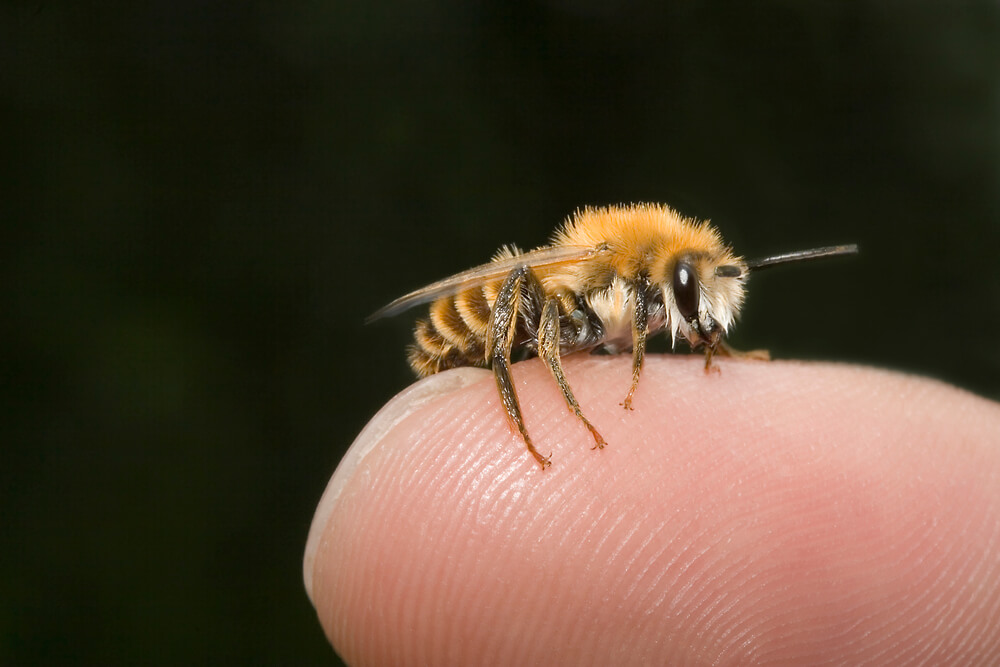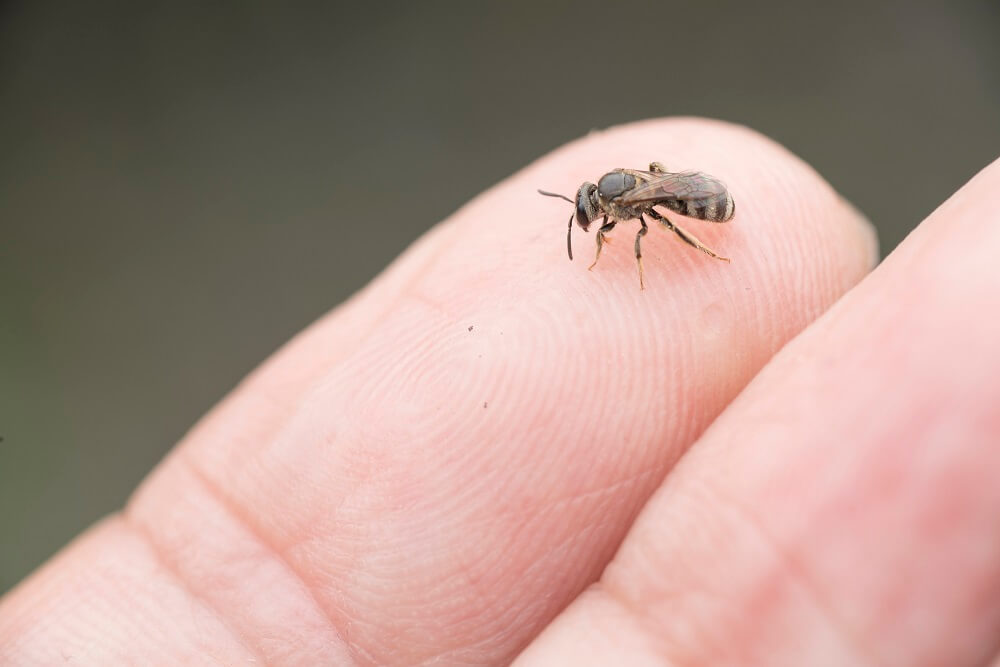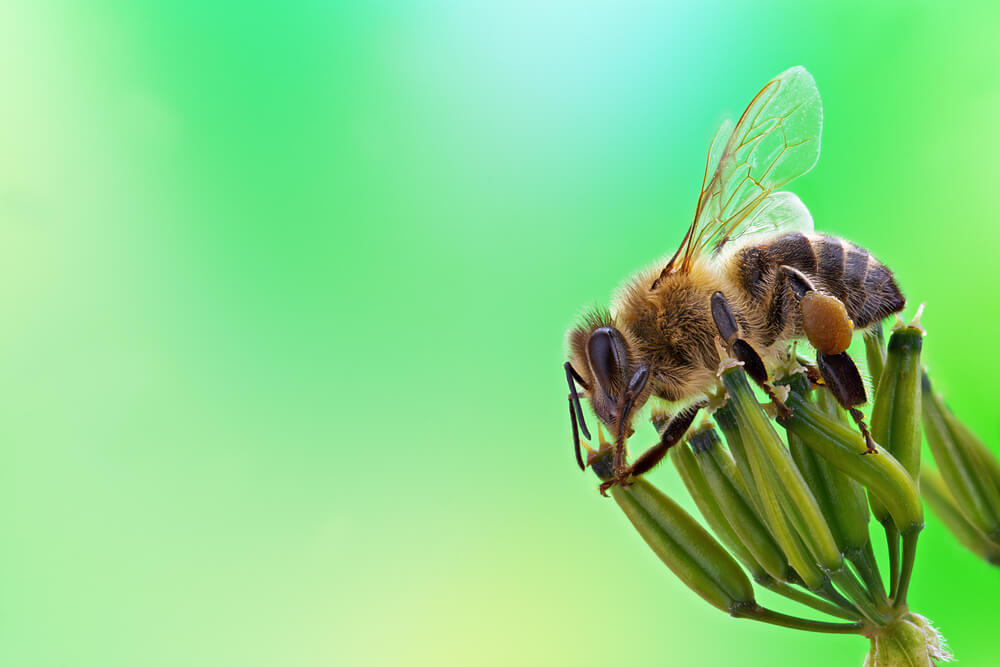Table of Contents:
Do Bees Die When They Sting?
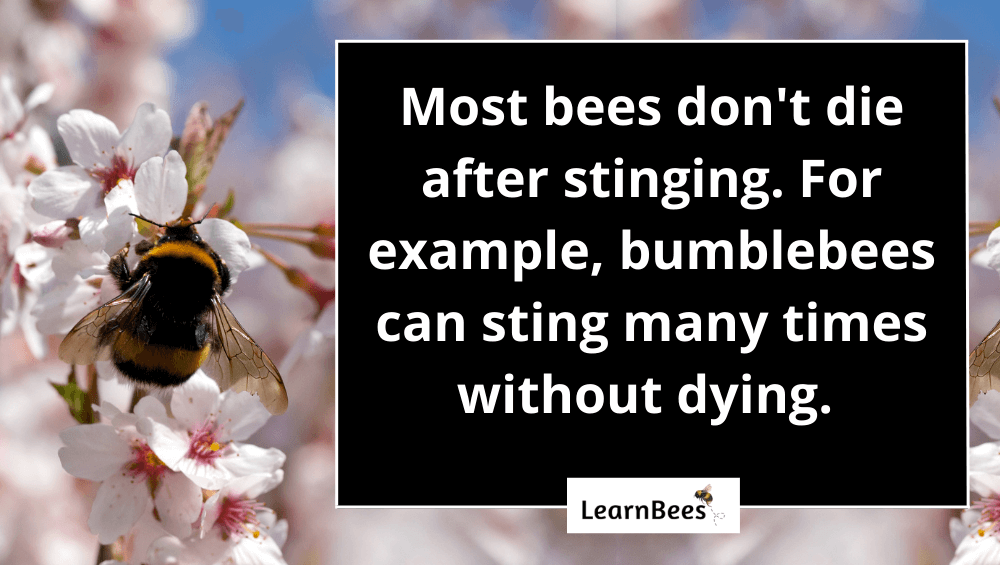
Here’s a fact that might surprise you:
Most bees don’t die when they sting.
In fact, bumblebees, carpenter bees, and mason bees can all sting multiple times without dying. This is because they don’t lose their stinger during the process.
You see, a bee’s stinger is a vital organ that’s attached to its abdomen. So if the stinger gets pulled out, the bee loses crucial organs. However, most bee species can sting without losing their stinger.
But honeybees aren’t so lucky.
Honeybees are one of the only bee species that die after stinging humans or other mammals.
This is because they have barbed stingers that “hook” into the skin. As a result, their stinger gets left behind once the honeybee tries to fly away. This not only rips out the bee’s stinger, but it also pulls out its abdomen.
Not good.
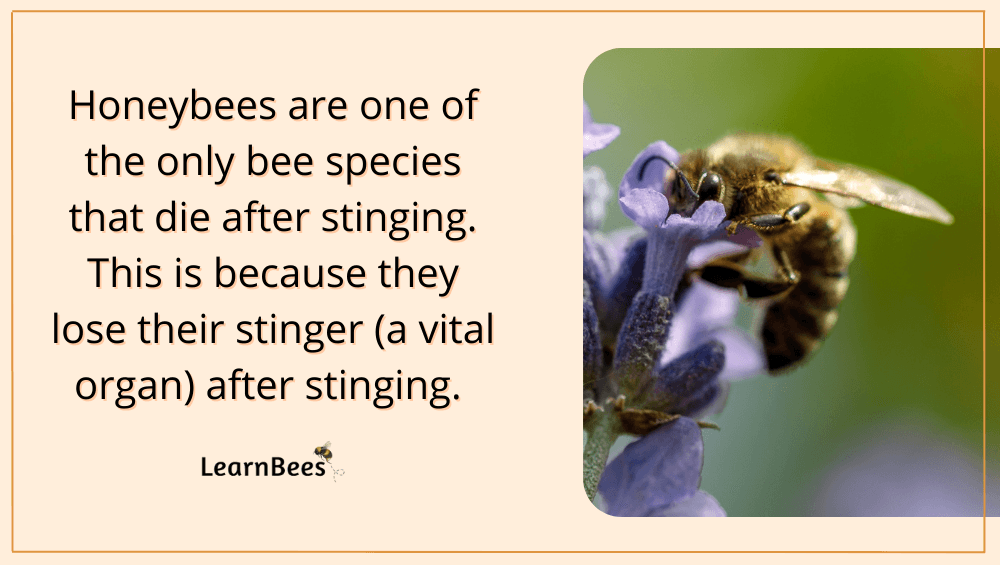
In contrast, other bee species have smooth stingers that can be used multiple times. Examples include bumblebees, leafcutter bees, carpenter bees, and mason bees.
But the good news?
Most bees are gentle creatures that don’t sting for no reason.
For example, I feel comfortable picking berries from my blueberry bushes while dozens of happy bees buzz around me.
I don’t mess with them. They don’t mess with me.
The exception is if you poke around a bee’s nest. This may startle the bees and cause them to become protective. Bees have to defend their hives adamantly because they have many predators trying to eat them and their honey.
In fact, a bear can destroy an entire honeybee hive in a matter of minutes.
Do Bees Know They Die When They Sting?
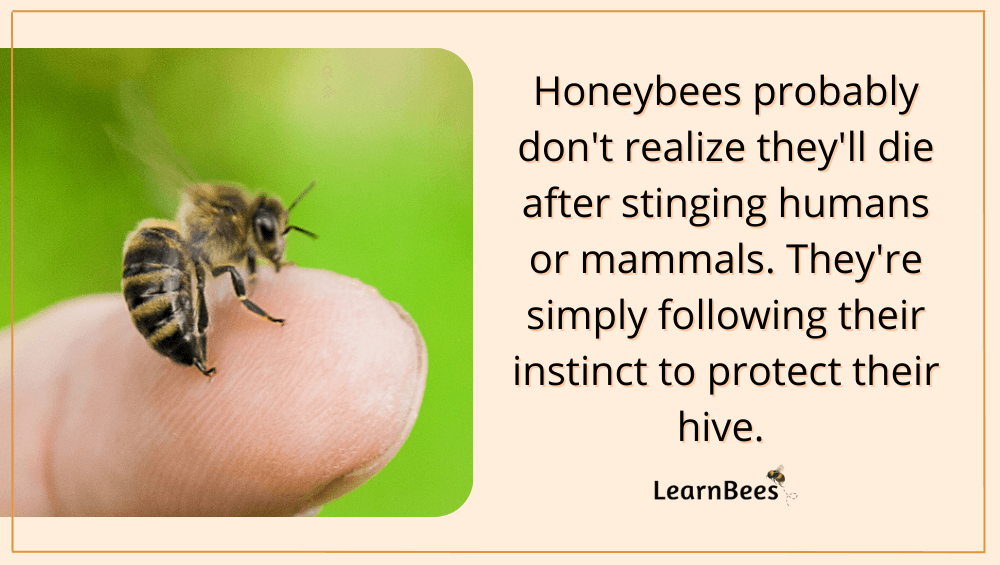
Remember:
Honeybees are one of the only species of bees that die after stinging humans. That said, it’s tough to safe they ‘know’ anything since we don’t know how they perceive things.
But here’s the thing:
The reason honeybees die after stinging humans is because our skin is thick enough to “catch” their stinger.
These same rules don’t apply to insects.
For example, honeybees can safely sting wasps several times to defend themselves. In fact, protecting their hive against invading insects is one reason why bees have stingers in the first place.
That said, honeybees probably don’t realize that human skin “catches” their stingers. They’re purely acting on instinct to defend their hive, not understanding that their stinger will get lodged into our skin.
This is also true for other mammals.
Honeybees risk losing their stinger when they sting bears, honey badgers, or skunks. These animals have thick skin like humans do.
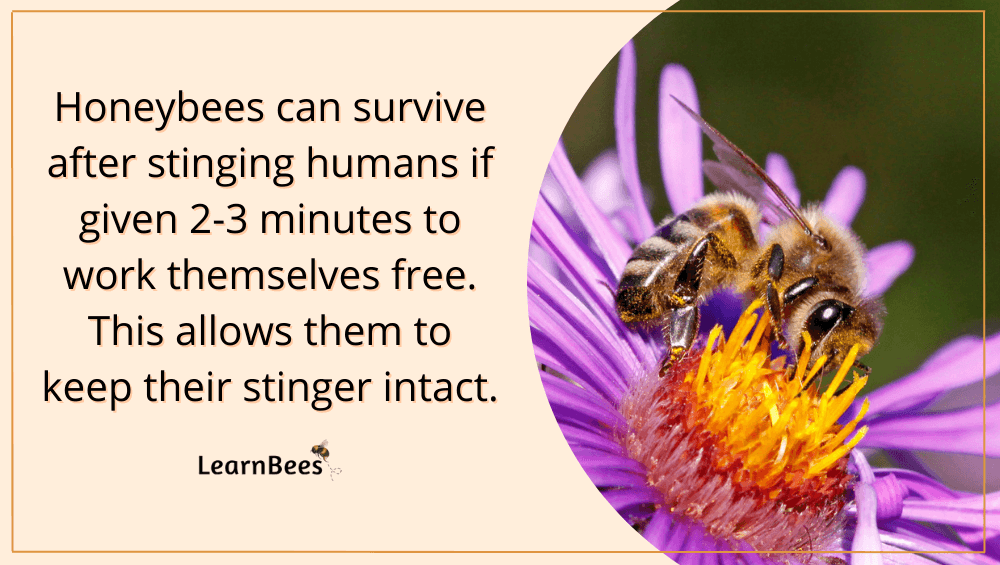
But, it’s hard to sting through thick fur, so honeybees aren’t always successful at reaching an animal’s skin to deliver a proper sting. They can, however, deliver a sting on an animal’s exposed nose or paw pads.
And here’s the kicker:
Honeybees can survive after stinging humans if you give them enough time to work their way free.
That’s right.
If given the opportunity, a honeybee will attempt to gently work itself loose from human skin. This process usually takes two to three minutes for a honeybee to pull off. And if she’s successful at doing so, she can fly away without harm.
But a person’s natural instinct is to swat away the bee once it stings. Unfortunately, the swatting encourages the honeybee to fly off, leaving its stinger behind.
But if you aren’t allergic to bee stings, you can spare the honeybee’s life by giving it two to three minutes to work itself free.
Can All Bees Sting?
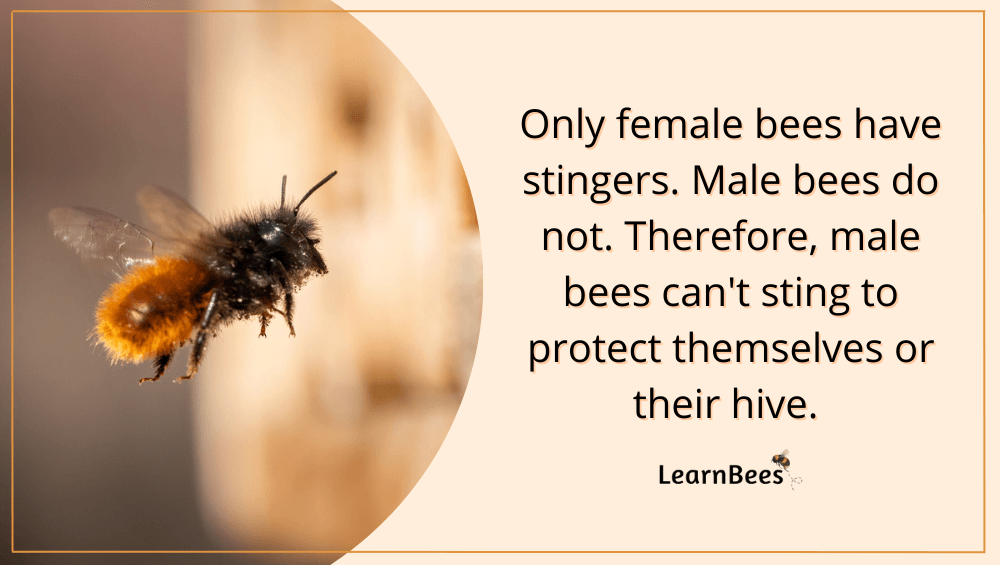
No, not all bees can sting.
For example, male bees can’t sting because they don’t have stingers. Stingers are modified egg-laying organs, so only female bees are equipped with them.
The same is true for wasps. Only female wasps can sting. Male wasps cannot.
But that doesn’t stop some male bees from putting on a good show. For example, male carpenter bees will try to defend their nests despite not having a stinger. They’ll buzz around intruders quickly to scare them off.
In most cases, this does the trick for protecting their nest.
But interestingly enough:
Most species of male bees are totally hands-off. Their sole purpose is to mate with a female bee. Most male bees don’t defend, clean, or maintain their hive. It’s the female bees’ responsibility to do most of the heavy lifting.
Now don’t get me wrong:
That doesn’t mean male bees are unimportant. They’re crucial for ensuring the future generation of bees.
It simply means that male bees have a different job.
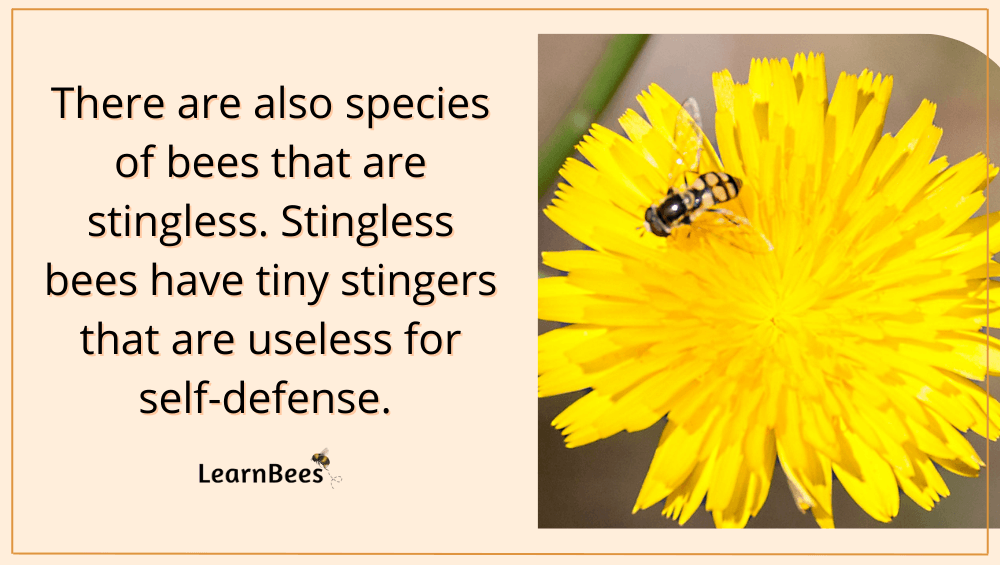
Besides male bees, there are also some species of bees that are stingless.
As their name suggests, stingless bees don’t sting. An estimated 550 species of stingless bees are primarily found in subtropical regions such as Australia and South America.
But here’s the thing:
Female stingless bees do have stingers. But their stingers are tiny and unsuitable for self-defense.
So how do they protect themselves?
By biting.
Additionally, some species of stingless bees secrete formic acid when they bite, causing a small blister where the bite happened. Formic acid is also the same chemical ant’s release when they bite.
Stingless bees belong to the family Apidae and are closely related to common honeybees, bumblebees, carpenter bees, and orchid bees. They produce small amounts of honey.
FAQs on “Do Bees Die When They Sting?”
- How long do bees take to die after stinging?
- Why do bees die when they sting but wasps don’t?
- Do queen bees die after stinging?
- Do bees know they die when they sting?
- Can a bee sting twice?
- Why do bees sting if it kills them?
- Do honeybees die when they sting?
- Do bumble bees die when they sting?
- Do carpenter bees die when they sting?
- Do mason bees die when they sting?
- Can bees survive after stinging?
How long do bees take to die after stinging?
“How fast does a bee die after it stings you?” is a common question we get.
The answer is it depends.
If the honeybee can successfully pull out its stinger, it can survive. But if the honeybee leaves its stinger behind, it will die within a minute or two of stinging.
Also, remember that most species of bees can sting several times without dying. This is because they have smooth stingers that can slip out easily. A bee’s stinger is a crucial organ attached to its abdomen. If they lose their stinger, they lose their life.
Examples of bees that don’t die after stinging include:
- Carpenter bees
- Bumble bees
- Mason bees
- Leafcutter bees
With that in mind, honeybees don’t die when they sting other insects because their stinger doesn’t get lodged inside the insect. The honeybee stinger only gets stuck in thick skin, such as in humans or mammals.
Honeybees can survive after stinging humans as long as they have two to three minutes to gently work themselves free without losing their stingers.
—> Go back to the FAQs on “Do Bees Die When They Sting?”
More to Explore:
Why do bees die when they sting but wasps don’t?
Wasps don’t lose their stingers like honeybees do. Wasps have smooth stingers that they can repeatedly use without dying.
But as mentioned, not all bees die after stinging. There are more than 20,000 bee species worldwide, and the majority of them can sting more than once without losing their life.
—> Go back to the FAQs on “Do Bees Die When They Sting?”
More to Explore:
Do queen bees die after stinging?
There are different species of queen bees. Queen bumblebees and queen honeybees are two common examples.
That said, most people are referring to queen honeybees when they say “queen bees.”
Queen honeybees don’t die after stinging. Their stingers aren’t barbed like worker honeybee stingers. This is important for queen honeybees because they use their stingers to kill other rival queen bees.
There can only be one queen honeybee in a hive. The queen is the mother of all the other bees in the colony. So when new queens hatch, the old queen and the new queens fight to the death. The winner becomes the sole queen of the hive.
—> Go back to the FAQs on “Do Bees Die When They Sting?”
More to Explore:
Do bees know they die when they sting?
It’s tough to say whether honeybees know they’ll die after stinging humans or mammals. We simply don’t know how they perceive the world.
We can speculate that honeybees probably don’t realize that stinging will result in their death.
Why?
Because honeybees can sting insects without dying. It’s not uncommon for honeybee hives to defend themselves against wasps or other insect intruders.
As a result, honeybees probably don’t realize that humans and mammals have thicker skin that grips onto their stingers. But again, this is all speculation. We don’t know what honeybees think when they sting humans or other mammals.
—> Go back to the FAQs on “Do Bees Die When They Sting?”
More to Explore:
Can a bee sting twice?
Yes, some bees can sting more than once.
There are more than 20,000 bee species worldwide. Most of these bees can sting several times without dying. This is due to their smooth stingers, which can easily slip out of the skin instead of getting left behind.
Examples of bees that can sting multiple times include:
- Mason bees
- Carpenter bees
- Bumble bees
- Leafcutter bees
These bees can sting you many times because their stingers aren’t barbed like honeybee stingers. Honeybees, on the other hand, can only sting once.
—> Go back to the FAQs on “Do Bees Die When They Sting?”
More to Explore:
Why do bees sting if it kills them?
Honeybees probably don’t realize that stinging mammals or humans will result in their death. They’re simply following their instinct to protect their hive.
But people often ask:
Why do bees die after they sting? Why do bees die when they sting someone?
When a honeybee stings, it leaves its stinger and venom sac in the skin. The bee then dies because its stinger is attached to its abdomen and gets ripped out.
So while bees may sting to protect their hive, it ultimately leads to their demise.
—> Go back to the FAQs on “Do Bees Die When They Sting?”
More to Explore:
Do honeybees die when they sting?
Not necessarily.
Honeybees don’t die after stinging insects like wasps or hornets. Their stingers don’t get lodged inside the insect. As a result, they can fly away unharmed.
But with humans or mammals?
It’s a different story. Honeybees die after stinging humans or mammals because their stingers get lodged inside the thicker skin. The bee then rips its abdomen out as it tries to fly away without its stinger.
—> Go back to the FAQs on “Do Bees Die When They Sting?”
More to Explore:
Do bumble bees die when they sting?
No, bumblebees don’t die when they sting. Their stingers don’t have barbs, so they don’t get left behind in the skin.
—> Go back to the FAQs on “Do Bees Die When They Sting?”
More to Explore:
- Ground Bees: Are They a Threat to Your Yard?
- Wasps vs. Honeybees: Are They Different?
- Do Bumble Bees Bite?
Do carpenter bees die when they sting?
No, carpenter bees don’t die when they sting. Like bumblebees, their stingers don’t have barbs in them. They have smooth stingers that don’t get stuck behind in the skin.
—> Go back to the FAQs on “Do Bees Die When They Sting?”
More to Explore:
- Do Carpenter Bees Pollinate?
- How Long Do Bumble Bees Live?
- Honeybees vs. Bumblebees: How Do They Compare?
Do mason bees die when they sting?
No, mason bees don’t die when they sting. Like other bee species with smooth stingers, their stingers can slip out of the skin without getting stuck. As a result, they can sting multiple times without dying.
However, it’s important to note that mason bees are gentle bees. They’re not known to sting people or animals unless handled directly. They’re solitary bees that aren’t protecting a hive or honey, so they aren’t territorial.
Also, most bees are more gentle than you might think. As long as they’re left alone and respected, most bees are passive-natured.
—> Go back to the FAQs on “Do Bees Die When They Sting?”
More to Explore:
Can bees survive after stinging?
Yes, most species of bees survive after stinging. Common examples include leafcutter bees, mason bees, and bumblebees. They can all sting without it being fatal.
This is a common question we get, along with many other questions such as:
Do bees die after they sting you? Do bees die after they sting someone? Do all bees die when they sting? Do bees always die when they sting? Why do bees die when they lose their stinger?
Honeybees are a popular exception because their stinger is different from other bees.
Honeybees have a barbed stinger that gets left behind in the skin after it punctures. The bee then rips its abdomen out as it tries to fly away, ultimately killing it.
So while most bees can sting multiple times without dying, honeybees die within minutes after stinging.
